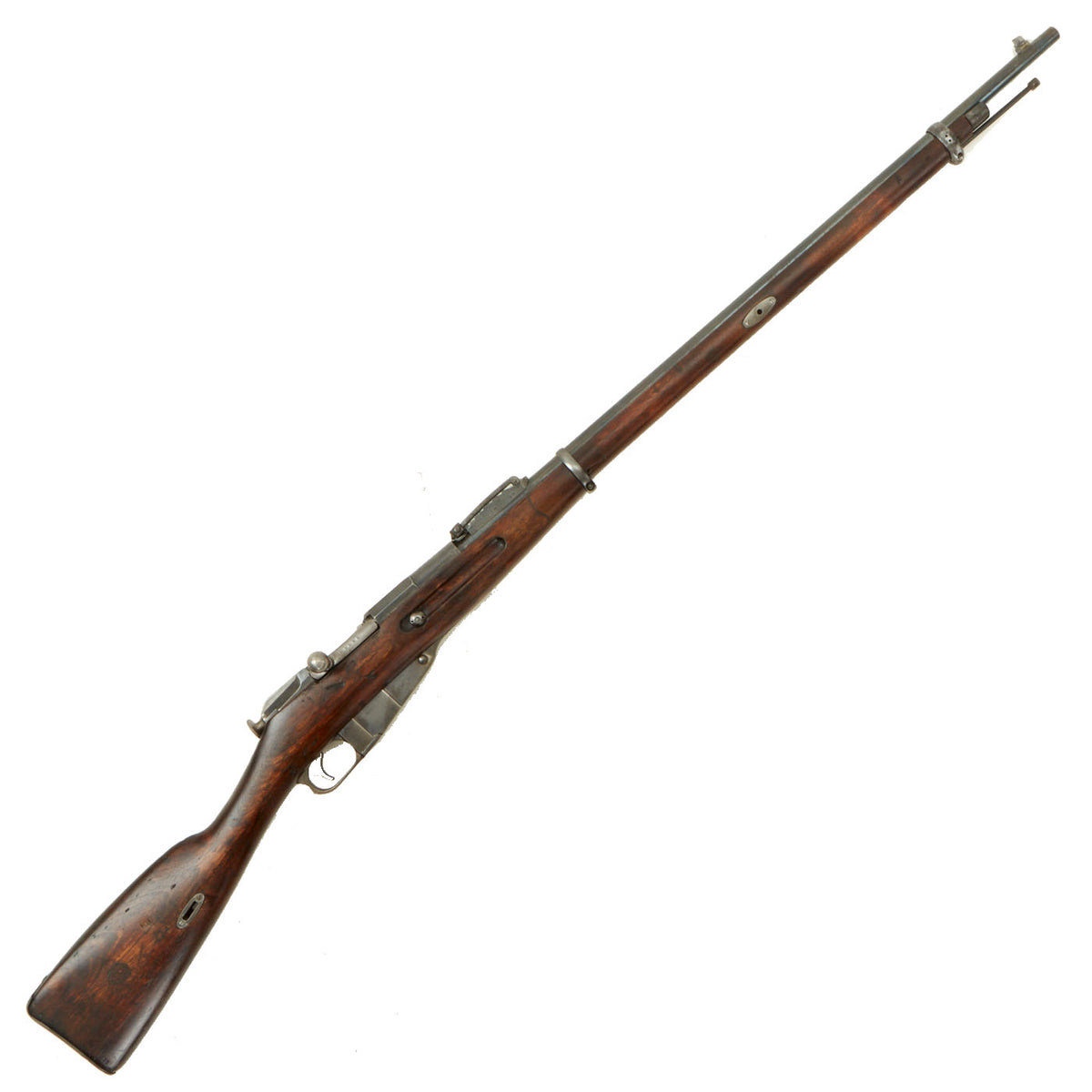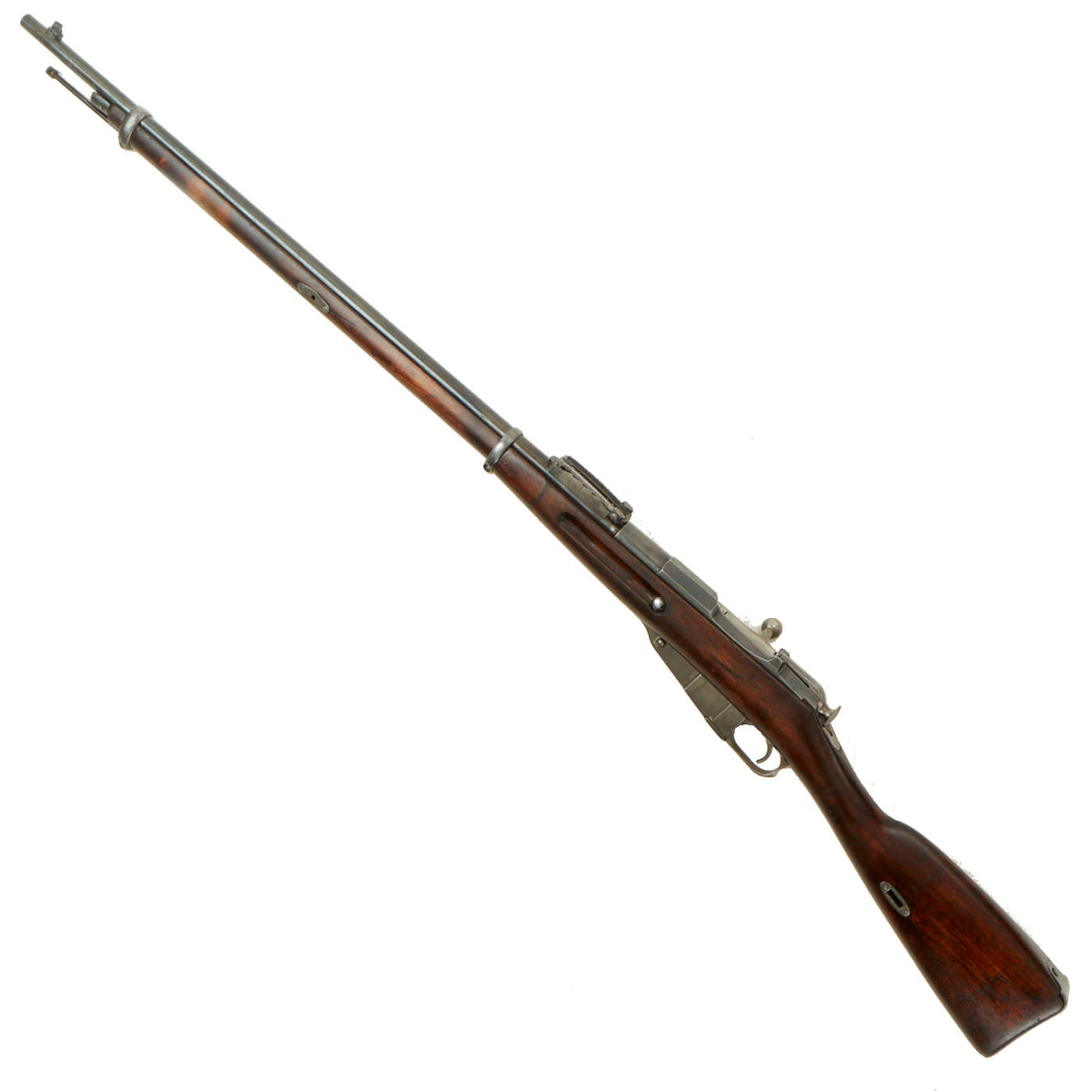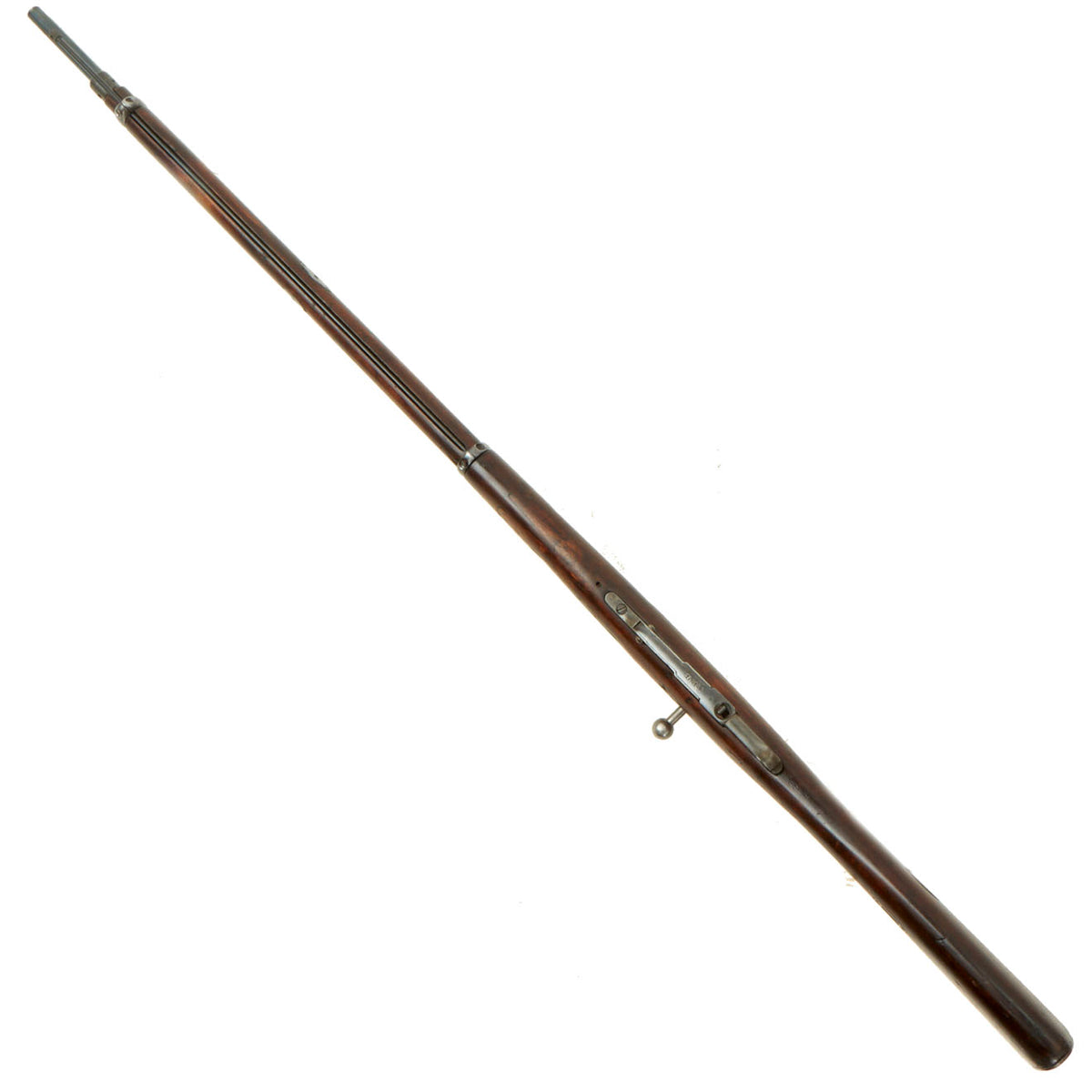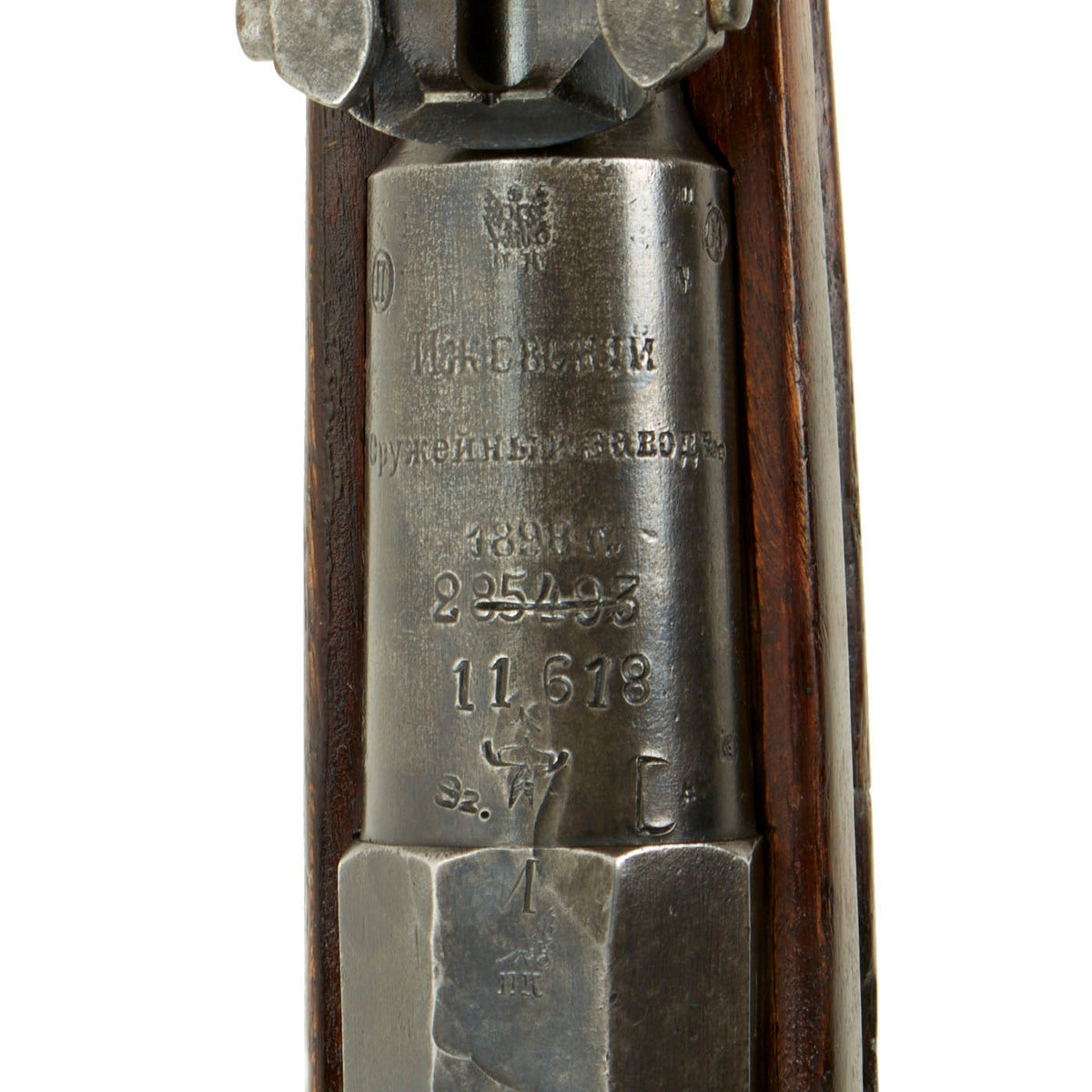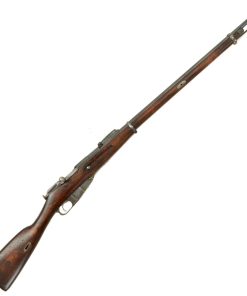Original Antique Finnish Captured Mosin-Nagant M/91 Infantry Rifle by Izhevsk Arsenal serial 11618 – dated 1898 Original Items
$ 1.995,00 $ 498,75
Original Item: Only One Available. These are so very rare, and this is the first example that we have seen in quite some time. A real pre-1898 Antique Russian Mosin-Nagant M1891 Full Length Rifle, more officially referred to as the “Three Line Infantry Rifle, Model of 1891.” This particular one was later refit in Finland to the Finnish M/91 Mosin-Nagant standard, and fitted with a new stock. It has lots of issue markings, as well as serial number 11618, which is on barrel and bolt, below crossed out number 285493. The right side of the barrel is marked with SA inside a rectangle, for Suomi Armeija (Finnish Army).
The Russian “Mosin-Nagant” bolt-action rifle is arguably the most-produced rifle in history, with around 37 million being produced in various versions in several different countries. This number easily surpasses the Lee-Enfield, Mauser GEW98 and Mauser K98K in number produced. The reasons for this are multiple, including both the size of Russia and later USSR, as well as the long service life of this design, which is still in use today in some locations.
The history of what is known as the “Mosin-Nagant” rifle begins in the late 19th century in Russia, following the Russo-Ottoman war. During the course of the war, it became apparent that Russian troops needed a modern bolt-action rifle to compete with the rest of the world, so they started evaluations in 1889 on what would become the general issue rifle for infantry troops. Three designs were submitted, and at the time in Russia bullet diameter was measured in “line”s, where one line was 1/10 of an inch. This is what gave rise to the official name of the rifle, the “3-line rifle, Model 1891”, as it was in .30cal, or 7.62mm. The name “Mosin-Nagant” is in reality somewhat of a misnomer, as the design chosen was designed by Mosin, not Nagant. However due to legal issues with Nagant over certain design aspects of the rifle, his name was attached to the design as well, leading to the name used in most of the world, the “Mosin-Nagant Model 1891”. Three other models would subsequently be put into service prior to WWI: the M1891 Dragoon, the M1891 Cossack, and the M1907 Carbine.;
When Finland achieved independence from Russia, over 190,000 Model 1891 infantry rifles were already stockpiled in the ex-Russian military depots within Finland. As a result, the rifle was adopted as the standard Finnish Army weapon, and surplus Mosin–Nagants were purchased from other European nations which had captured them during World War I. The official designation of these were “3-линии пехотная винтовка образца 1891–го года” which translates to “Three Line Infantry Rifle, Model of 1891”. These rifles were then overhauled to meet Finnish Army standards and designated M/91.
This entailed replacing the stock with a new one, constructed from two pieces of wood with a glued finger joint in the middle. The new stock featured traditional sling swivels fitted into escutcheons, instead of the slots used on the Russian types, though sometimes they were retrofitted with the old style, as this example was on the butt stock. The fore stock sling swivel is also missing.
As with most, this example has the cross bolt to reinforce the stock against recoil, and the rear sight correctly goes up to 3200 arschini, an archaic measurement used by Russia through the first world war. Roughly equal to 71.12 cm, the ranges on the left side of the sight have been crossed out, and new measurements in meters added in hundreds of meters (12 x 100 arshíny = 8 1/2 x 100m). The M/91 was the most widely issued Finnish rifle in both the Winter War and the Continuation War.
The receiver displays an Imperial Russian Double Headed Eagle across the chamber ring over Cyrillic letters Л К,, which is also seen on the upper end of the receiver.
The markings on the barrel are:
(Imperial Eagle)
Л К
ИЖЕВСКІЙ
Оружейньійзаводъ.
1898г.
11618
(Bow & Arrow)
These indicates original manufacture in 1898 at Izhevsk arsenal, a major producer of Mosin-Nagant rifles and carbines. The factory itself was founded in 1807 at the request of the Czar, and continues to manufacturer small arms do this day. Other parts of the rifle are also marked with the Bow and Arrow proof of Izhevsk, Czarist markings which were discontinued following the Russian revolution and subsequent civil war.
Condition of the rifle is very good, especially considering the age and amount of service it must have seen. The stock is in good condition, though it does look to have been arsenal refinished at least once, and now has a lovely brown color. The metalwork is in good shape, mostly a worn blued finish with a bright steel bolt. There is some past pitting, now removed, which has made some markings faint. It still retains the original cleaning rod, which is in great shape, and still threads correctly into the stock retaining block.
The rifle cycles well, with a crisp dry fire. The bore shows clear lands and grooves with a mostly bright finish, showing just a bit of rounding on the grooves. The first inch of the barrel closest to the muzzle has been counterbored, thought to improve accuracy by removing worn lands at the muzzle.
A wonderful piece of Firearms and European History! Made in Russian in 1898, and then later used against them by Finland during the WWII Era. Ready do display!
Specifications-
Year of Manufacture: 1898
Caliber: 7.62×54mmR Russian
Cartridge Type: Centerfire Cartridge
Barrel Length: 31 1/2 Inches
Overall Length: 51 1/2 Inches
Action type: Bolt Action
Feed System: 5 Round Internal
Fast Shipping with Professional Packaging
Thanks to our longstanding association with UPS FedEx DHL, and other major international carriers, we are able to provide a range of shipping options. Our warehouse staff is expertly trained and will wrap your products according to our exact and precise specifications. Prior to shipping, your goods will be thoroughly examined and securely secured. We ship to thousands clients each day across multiple countries. This shows how we're dedicated to be the largest retailer on the internet. Warehouses and distribution centres can be located throughout Europe as well as the USA.
Note: Orders with more than one item will be assigned a processing date depending on the item.
Before shipping before shipping, we'll conduct a thorough inspection of the items you have ordered. Today, the majority of orders will be delivered within 48 hours. The delivery time will be between 3-7 days.
Returns
The stock is dynamic and we cannot completely manage it because multiple stakeholders are involved, including our factory and warehouse. So the actual stock may alter at any time. It's possible that you may not receive your order once the order has been made.
Our policy is valid for a period of 30 days. If you don't receive the product within 30 days, we are not able to issue a refund or an exchange.
You can only return an item if it is unused and in the same state as the day you received it. You must have the item in its original packaging.
Related products
Uncategorized
Uncategorized
Uncategorized
Band of Brothers ORIGINAL GERMAN WWII Le. F.H. 18 10.5cm ARTILLERY PIECE Original Items
Uncategorized
Uncategorized
Uncategorized
Uncategorized
Uncategorized
Uncategorized
Uncategorized
Uncategorized
Armoured Fighting Vehicles of the World: AFVs of World War One (Hardcover Book) New Made Items
Uncategorized
Uncategorized
Uncategorized
Uncategorized
Uncategorized
Uncategorized
